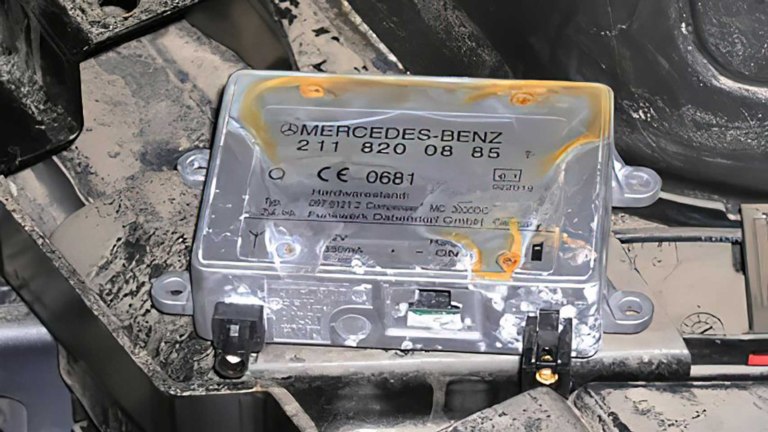Electrical Problems
Quick answer: Electrical problems are faults in a car’s wiring, connectors, sensors or control units that cause things to stop working properly – often showing up as warning lights, intermittent glitches or flat batteries – and are frequently triggered or made worse by water leaks and damp under carpets, in sills and in the boot.
One of the first signs that a car might have a leak is the appearance of electrical problems. Two of the most common we encounter are electric windows that stop working, or warning lights on the dashboard about airbags.
Modern cars are packed full of computers, and while some involved in engine management are in the engine compartment, many of the others may be hidden under the carpets. These include the main electronic control unit, Bluetooth, media and the airbag control units. Some cars have up to 150 ECUs.

If damaged, these can be extremely costly to replace, in fact, electronics account for up to 40% of a new car's value. Thankfully, most of these modules are sealed units which are water-resistant, but they are not designed to be submerged. The electrical connectors are not especially waterproof, electrical faults can cause power surges which can damage processors, and it is only a matter of time before water finds its way into a sealed unit.
Much of the wiring loom is hidden beneath the carpets, and if sitting in a puddle of water, capillary action will pull water along the bundles of wires, to connectors which can easily corrode.
We often find that the cause of leaks is perished and shrunken grommets, which are designed to allow electrical wiring to pass through the bulkhead, so the path of the water is following the wiring.
When a car is wet or damp, you will get condensation, which you will see on the glass. But if it is on the glass, it is likely to be coating other hard surfaces, such as all the electrical connectors. Often, this is where problems will occur first leading to electrical faults and blown fuses.
This is why it is essential to properly dry a car, and it isn't sufficient to just fix a leak.
What it means
Electrical problems cover anything from a single window switch not working to a car that will not start or shows half the dashboard lit up with warnings. Modern cars have extensive wiring looms, dozens of control units (ECUs), sensors and connectors running under carpets, along sills, into doors and through the boot area. When these components are damaged, corroded or shorted – especially by water leaks and long-term damp – they can cause faults that are intermittent, difficult to trace and sometimes expensive to put right.
Why it matters
- Safety systems rely on electrics: Airbags, ABS, stability control, power steering and seatbelt pre-tensioners all depend on healthy wiring and modules. Water-related electrical problems can compromise safety systems, not just convenience features.
- Intermittent faults are hard to diagnose: Damp connectors and wiring often cause faults that come and go with temperature and humidity. This can lead to repeat visits and parts being replaced without the underlying cause – water damage – being addressed.
- Linked to leaks and damp under carpets: Many looms and modules run in the very places that fill first when a car leaks – front and rear footwells, sills, cross members and the boot floor. If leaks are ignored, corrosion creeps along the wiring unseen.
- Can cause drains and flat batteries: Water-damaged modules and corroded connectors may draw power when the car is “asleep”, leading to parasitic drains, flat batteries and starting problems.
Where you will see it
You will see electrical problems mentioned in leak reports, diagnostics and water damage assessments. Typical comments include corrosion present on wiring under driver’s seat, multiple electrical faults likely linked to water in rear quarter, control unit in spare wheel well affected by damp or intermittent door locking fault traced to corroded connector in sill loom. After drying and decontamination, notes may record that electrical systems have been re-checked and tested.
Context
Electrical problems often sit at the end of a chain that starts with a physical leak. Water enters via doors, rear vents, drainage pipes, scuttle, sunroof cassette or grommets, then collects under carpets, in cross members, box sections and boot wells. Over time, wiring and connectors in these areas oxidise, pins turn green, and modules can suffer internal damage. A proper repair plan connects the dots – find and fix the leak, lift carpets, dry and decontaminate, then inspect and, where necessary, repair or replace affected wiring and modules. Simply clearing fault codes or swapping a control unit without tackling the damp source usually means the problems return.
Common mistakes
- Chasing electrical symptoms with scan tools and parts replacement while ignoring obvious signs of past or present water leaks.
- Drying the carpet surface but leaving damp soundproofing and wiring looms wet underneath, allowing corrosion – and electrical problems – to continue.
- Assuming a new control unit will solve everything without checking the condition of connectors, earth points and the loom feeding it.
- Resetting fault codes after a leak without a follow-up plan to monitor for returning faults once the car has been properly dried and used in wet weather.
Written by Danny Argent. Last updated 09/12/2025 03:17
